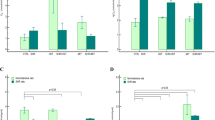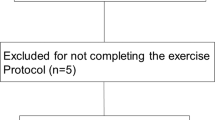Abstract
Systemic arterial hypertension has been associated with the majority deaths from cardiovascular disease, especially among the elderly population, and the imbalance between antioxidant and pro-oxidants has been associated with hypertension. This study analyzed the acute responses of cardiorespiratory and oxidative stress parameters to low intensity aerobic exercise (LIAE) with blood flow restriction (BFR) in hypertensive elderly women. The experimental group consisted of 16 hypertensive women (67.2 ± 3.7 years) who underwent a progressive treadmill test and performed three exercise protocols in random order: high intensity (HIAE), low intensity aerobic exercise (LIAE) and low intensity aerobic exercise with blood flow restriction (LIAE + BFR). Data analysis showed that blood pressure and heart rate augmented from rest to post effort (p < 0.05) and reduced from post effort to recovery (p < 0.05) in all protocols. The values of lipid peroxidation were higher after 30 min of recovery when compared to the moment at rest in the LILIAE + BFR (p < 0.05). The same occurred with glutathione-S-transferase and superoxide dismutase activity. However, non-protein thiols levels (NPSH) reduced after 30 min of recovery when compared to the moment at rest in the LILIAE + BFR protocol (p < 0.05). In the HIAE and LIAE + BFR protocols, the levels of NPSH were lower at 30 min of recovery when compared to the same moment in the LIAE protocol (p < 0.05). LIAE + RBF produces an oxidative status and hemodynamic stimulus similar to HIAE. Taken together, these results support the indication of LIAE with BFR in chronic intervention protocols, with potential benefits for the hypertensive elderly population.





Similar content being viewed by others
References
World Health Organization (2013) A global brief on hypertension: silent killer, global public health crisis. World Health Day 2013. World Health Organization, Geneva
Malachias MVB, Souza WKSB, Plavnik FL, Rodrigues CIS, Brandão AA, Neves MFT (2016) 7ª Diretriz brasileira de hipertensão arterial. Arq Bras Cardiol 107:1–103
Halliwell B, Gutteridge JMC (1999) Free radicals in biology and medicine. Oxford University press, New York
Slater TF (1984) Free radical mechanisms in tissue injury. Biochem J 222:1–15
Hamer M, Ingle G, Carroll S, Stamatakis E (2012) Physical activity and cardiovascular mortality risk: possible protective mechanisms? Med Sci Sports Exerc 44:84–88. https://doi.org/10.1249/MSS.0b013e3182251077
Mora S, Cook N, Buring JE, Ridker PM, Lee IM (2007) Physical activity and reduced risk of cardiovascular events: potential mediating mechanisms. Circulation 116:2110–2118. https://doi.org/10.1161/CIRCULATIONAHA.107.729939
Sato Y (2005) The history and future of Kaatsu training. Int J Kaatsu Train Res 1:1–5
Schulz KF, Altman DG, Moher D (2010) CONSORT 2010 statement: updated guidelines for reporting parallel group randomized trials. Ann Int Med 152:726–732. https://doi.org/10.7326/0003-4819-152-11-201006010-00232
Ellman GL (1959) Tissue sulfhydryl groups. Arch Biochem Biophys 82:70–77
Jacques-Silva MC, Nogueira CW, Broch LC, Flores EM, Rocha JB (2001) Diphenyl diselenide and ascorbic acid changes deposition of selenium and ascorbic acid in liver and brain of mice. Pharmacol Toxicol 88:119–125. https://doi.org/10.1034/j.1600-0773.2001.d01-92.x
Jentzsch AM, Bachmann H, Fürst P, Biesalski HK (1996) Improved analysis of malondialdehyde in human body fluids. Free Radic Biol Med 20:251–256. https://doi.org/10.1016/0891-5849(95)02043-8
Levine RL, Garland D, Oliver CN, Amici A, Climent I, Lenz AG, Ahn BW, Shaltiel S, Stadtman ER (1990) Determination of carbonyl content in oxidatively modified proteins. Methods Enzymol 186:464–478. https://doi.org/10.1016/0076-6879(90)86141-H
Miranda KM, Espey MG, Wink DA (2001) A rapid, simple spectrophotometric method for simultaneous detection of nitrate and nitrite. Nitric Oxide 5:62–71. https://doi.org/10.1006/niox.2000.0319
Warholm M, Guthenberg C, von Bahr C, Mannervik B (1985) Glutathione transferases from human liver. Methods Enzymol 113:499–504
Misra HP, Fridovich I (1972) The role of superoxide anion in the autoxidation of epinephrine and simple assay for superoxide dismutase. J Biol Chem 247:3170–3175
Metcalf JA, Gallin JI, Nauseef WM, Root RK (1986) Laboratory manual of neutrophil function. Raven Press, New York
Renzi CP, Tanaka H, Sugawara J (2010) Effects of leg blood flow restriction during walking on cardiovascular function. Med Sci Sports Exerc 42:726–732. https://doi.org/10.1249/MSS.0b013e3181bdb454
Iida H, Kurano H, Takano H, Kubota N, Morita T, Meguro K, Sato Y, Abe T, Yamazaki Y, Uno K, Takenaka K, Hirose K, Nakajima T (2007) Hemodynamic and neurohumoral responses to the restriction of femoral blood flow by KAATSU in healthy subjects. Eur J Appl Physiol 100:275–285. https://doi.org/10.1007/s00421-007-0430-y
Ferreira MLV, Sardeli AV, Souza GV, Bonganha V, Santos LDC, Castro A, Cavaglieri CR, Chacon-Mikahil MPT (2017) Cardiac autonomic and haemodynamic recovery after a single session of aerobic exercise with and without blood flow restriction in older adults. J Sports Sci 35:2412–2420. https://doi.org/10.1080/02640414.2016.1271139
Neto GA, Pereira-Júnior PP, Mura L, Carta MG, Machado S (2015) Effects of different types of physical exercise on the perceived quality of life in active elderly. CNS Neurol Disord Drug Targets 14:1152–1156. https://doi.org/10.2174/1871527315666151111130045
Anunciação PG, Polito MD (2011) A review on post-exercise hypotension in hypertensive individuals. Arq Bras Cardiol 96:100–109. https://doi.org/10.1590/S0066-782X2011005000025
Ciolac EG, Guimarães GV, D’Avila VM, Bortolotto LA, Doria EL, Bocchi EA (2009) Acute effects of continuous and interval aerobic exercise on 24-h ambulatory blood pressure in long-term treated hypertensive patients. Int J Cardiol 133:381–387. https://doi.org/10.1016/j.ijcard.2008.02.005
Moraes MR, Bacurau RF, Ramalho JD, Reis FC, Casarini DE, Chagas JR, Oliveira V, Higa EM, Abdalla DS, Pesquero JL, Pesquero JB, Araujo RC (2007) Increase in kinins on post-exercise hypotension in normotensive and hypertensive volunteers. Biol Chem 388:533–540. https://doi.org/10.1515/BC.2007.055
Fagard RH, Cornelissen VA (2007) Effect of exercise on blood pressure control in hypertensive patients. Eur J Cardiovasc Prev Rehabil 14:12–17. https://doi.org/10.1097/HJR.0b013e3280128bbb
Brandão Rondon MUP, Alves MJ, Braga AM, Teixeira OT, Barretto AC, Krieger EM, Negrão CE (2002) Postexercise blood pressure reduction in elderly hypertensive patients. J Am Coll Cardiol 39:676–682. https://doi.org/10.1016/S0735-1097(01)01789-2
Quinn TJ (2000) Twenty-four-hour, ambulatory blood pressure responses following acute exercise: impact of exercise intensity. J Hum Hypertens 14:547–553. https://doi.org/10.1038/sj.jhh.1001106
May AK, Brandner CR, Warmington SA (2017) Hemodynamic responses are reduced with aerobic compared with resistance blood flow restriction exercise. Physiol Rep 5:1–10. https://doi.org/10.14814/phy2.13142
Staunton CA, Maio AK, Brandner CR, Warmington SA (2015) Haemodynamics of aerobic and resistance blood flow restriction exercise in young and older adults. Eur J Appl Physiol 115:2293–2302. https://doi.org/10.1007/s00421-015-3213-x
Sugawara J, Tomoto T, Tanaka H (2015) Impact of leg blood flow restriction during walking on central arterial hemodynamics. Am J Physiol Regul Integr Comp Physi 309:R732–R739. https://doi.org/10.1152/ajpregu.00095.2015
Ozaki H, Brechue WF, Sakamaki M, Yasuda T, Nishikawa M, Aoki N, Ogita F, Abe T (2010) Metabolic and cardiovascular responses to upright cycle exercise with leg blood flow reduction. J Sports Sci Med 9:224–230
Omer K, Nermin G, Ali A, Mehmet A, Unal D, Sezen KS, Hakan K (2017) Tourniquet-induced ischaemia-reperfusion injury: the comparison of antioxidative effects of small-dose propofol and ketamine. Rev Bras Anestesiol 67:246–250. https://doi.org/10.1016/j.bjan.2016.10.007
Bouzid MA, Hammouda O, Matran R, Robin S, Fabre C (2015) Influence of physical fitness on antioxidant activity and malondialdehyde level in healthy older adults. Appl Physiol Nutr Metab 40:582–589. https://doi.org/10.1139/apnm-2014-0417
Steinberg JG, Ba A, Brégeon F, Delliaux S, Jammes Y (2007) Cytokine and oxidative responses to maximal cycling exercise in sedentary subjects. Med Sci Sports Exerc 39:964–968. https://doi.org/10.1097/mss.0b013e3180398f4b
Steinberg JG, Delliaux S, Jammes Y (2006) Reliability of different blood indices to explore the oxidative stress in response to maximal cycling and static exercises. Clin Physiol Funct Imaging 26:106–112. https://doi.org/10.1111/j.1475-097X.2006.00658.x
Laaksonen DE, Atalay M, Niskanen L, Uusitupa M, Hanninen O, Sen CK (2013) Blood glutathione homeostasis as a determinant of resting and exercise-induced oxidative stress in young. Redox Rep 1:53–59. https://doi.org/10.1179/135100099101534648
Fisher-Wellman K, Bloomer RJ (2009) Acute exercise and oxidative stress: a 30-year history. Dyn Med 8:1–25. https://doi.org/10.1186/1476-5918-8-1
Michailidis Y, Jamurtas AZ, Nikolaidis MG, Fatouros IG, Koutedakis Y, Papassotiriou I, Kouretas D (2007) Sampling time is crucial for measurement of aerobic exercise-induced oxidative stress. Med Sci Sports Exerc 39:1107–1113. https://doi.org/10.1249/01.mss.0b013e318053e7ba
Powers SK, Lennon SL (1999) Analysis of cellular responses to free radicals: focus on exercise and skeletal muscle. Proc Nutr Soc 58:1025–1033
Farney TM, Mccarthy CG, Canale RE, Schilling BK, Whitehead PN, Bloomer RJ (2012) Absence of blood oxidative stress in trained men after strenuous exercise. Med Sci Sports Exerc 44:1855–1863. https://doi.org/10.1249/MSS.0b013e3182592575
Ingul CB (2018) Low volume, high intensity: time-efficient exercise for the treatment of hypertension: invited Commentary. Eur J Prev Cardiol. https://doi.org/10.1177/2047487318760040. Available at http://journals.sagepub.com.
Weston KS, Wisløff U, Coombes JS (2014) High-intensity interval training in patients with lifestyle-induced cardiometabolic disease: a systematic review and meta-analysis. Br J Sports Med 48:1227–1234. https://doi.org/10.1136/bjsports-2013-092576
Acknowledgements
We thank Unochapecó University for his financial support.
Author information
Authors and Affiliations
Corresponding author
Ethics declarations
Conflict of interest
It is an academic work and there is no conflict of interest.
Rights and permissions
About this article
Cite this article
Barili, A., Corralo, V.d., Cardoso, A.M. et al. Acute responses of hemodynamic and oxidative stress parameters to aerobic exercise with blood flow restriction in hypertensive elderly women. Mol Biol Rep 45, 1099–1109 (2018). https://doi.org/10.1007/s11033-018-4261-1
Received:
Accepted:
Published:
Issue Date:
DOI: https://doi.org/10.1007/s11033-018-4261-1




